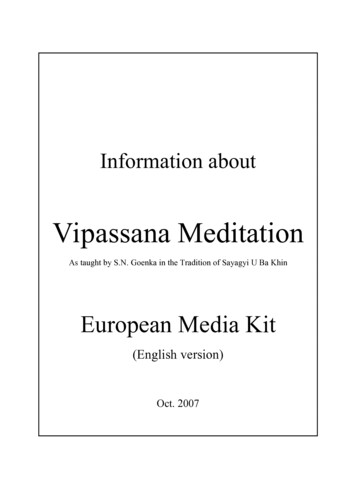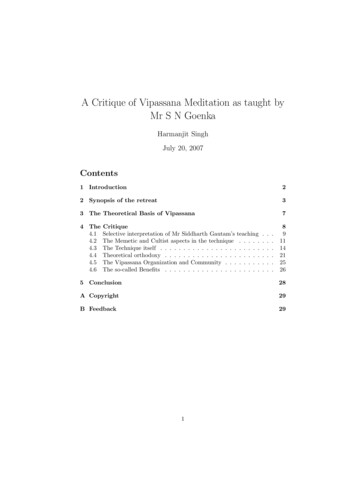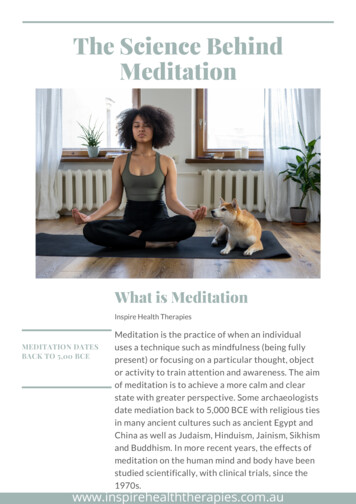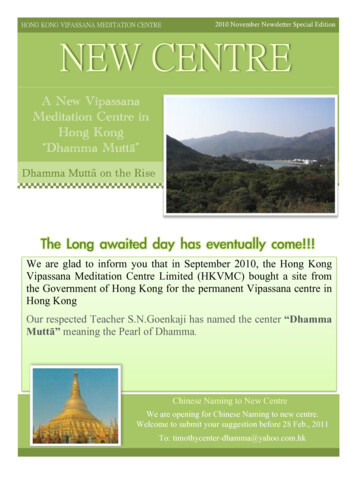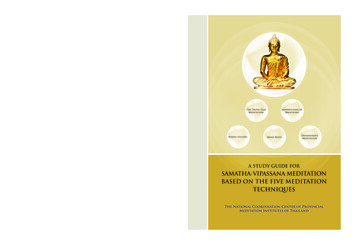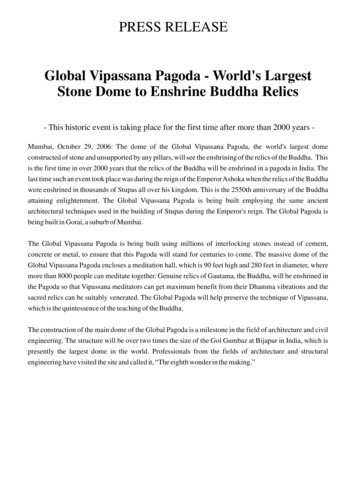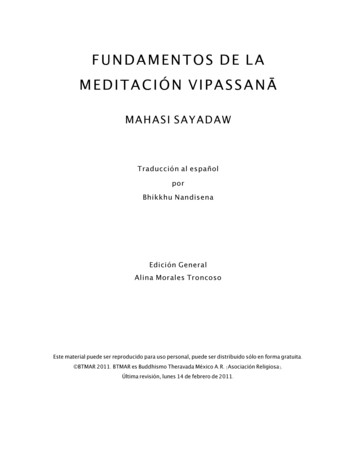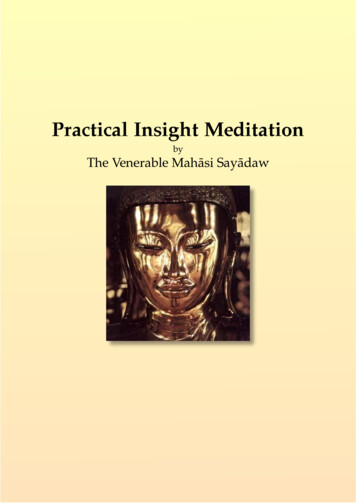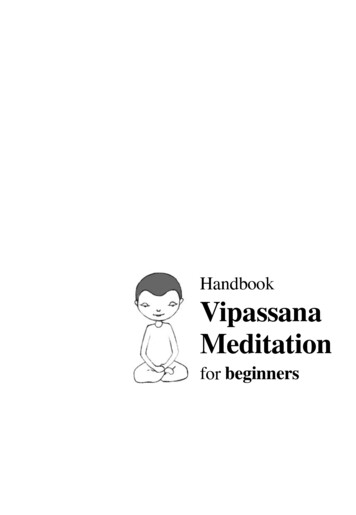
Transcription
HandbookVipassanaMeditationfor beginners
HandbookVipassana Meditationfor beginnersby Phra Athikan Somsak SoradoAbbot of Wat Bhaddanta AsabharamFirst edition 1,000 copies May 2009Print SMK Printing Co.Ltd ; Bangkok , ThailandISBN 978-974-94671-2-1Art WorkIllustratorDesignsabaya.multiply.comChavisa ChawalitsaeweeBhusit Indraduta copyright ; No reservations for copyright. Dhamma is freely given; allmay freely copy and print this handbook.Published for Free DistributionSAPPA DANAM DHAMMA DANAM CHINATI“TO OFFER DHAMMA AS A GIFT EXCEEDSALL KINDS OF OFFERINGS”
PrefaceThis is a beginners’ handbook for awarenessdevelopment according to the Four Foundations ofMindfulness. I have compiled here a set of instructionsfrom my own personal experience that I have heard, read,written and taken into memory from the Tipitika and otherBuddhist texts. I have received instructions fromMeditation Masters of the Vipassana Lineage that I havedirectly and intensively put into practice. VipassanaMeditation Grandmaster Dr. Bhaddanta Asabha Mahatherawas my kalyanamittata who gave instructions andinterviews with good results.The core substance of this handbook has beencompiled directly from personal experience andisespecially for meditators who wish to put the instructionsinto practice. Many meditators have provided feedbackthat they have greatly benefited from this handbook andthat they have received good results to a certain extent.They further urged that more copies should be printed andthat they were willing to sponsor the cost of printing.Before being compiled, this manual only consisted of afew pages of notes which I had distributed to meditatorswho came to practice. Later, all the notes were compiledinto a handbook.
I hereby give permission to those who wish to printthis handbook and distribute it. I do not make reservationsfor copyright. Dhamma is freely given; all may freelycopy and print this handbook.For those that have yet to directly experiencevipassana meditaton according to the Four Foundations ofMindfulness this handbook will give instructions on whatand how to physically and emotionally prepare oneselfbefore entering into a meditation retreat. Core principlesand method are elaborated – including standing, walking,sitting, lying down, lowering the body, lifting the body up,and stretching. The benefits of Vipassana Meditation arealso given. This book further elaborates on bare awarenessof knowing pleasant feelings, painful feelings, neitherpleasant-nor-painful feeling, the bare awareness ofknowing the thinking process, the five hindrances, internalsense fields, external sense fields including the bareawareness of the Four Foundations of Mindfulness(mindfulness of body, feelings, thoughts and ideas), as itreally is.While reading thisbook, one may feel that it is notenjoyable as the handbook is filled with instructions,general principles, method of practice, and theencouragement to put instructions into direct practice; andeventually to reap the benefits of Vipassana Meditation indue course. One must put the method laid out here intopractice to assure oneself that this meditation method
really works. Thus, this handbook is not a scholarly studynor a book for recreation.Finally, it is hoped that this handbook will be a goodfriend for beginnersand will provide a firm foundation forthose who walk the path towards liberation andenlightenment. For those who see the dangers of thecontinued rounds of existence, Samsara, and for those onthe journey towards the path toward liberation, may theyall be well. May the wholesome cause and effecteventuallylead them to the shore of Nibbana.Anumodana and thank you to the translators,financial sponsors and all those involved in publishing thisfirst edition of the Handbook of Vipassana Meditation forbeginners. The opportunity in spreading the Dhamma or infreely giving the Dhamma, the Buddha has stated as beingthe highest act of generosity.I hereby pay respects to the Triple Gems and may theTriple Gems offer protection to all – to be free fromdiseases, having wisdom and right understanding; and mayall be successful in their life endeavors.With MettaPhra Athikan Somsak SoradoAbbot of Wat Bhaddanta Asabharam
ContentsPrefaceHow to prepare before entering into Vipassana MeditationMethod of accepting the eight Precepts andmeditation retreatMeaning of ContemplationVipassana MeditationContemplation of body (Kayanupassana)Standing ContemplationWalkingTurningWalking stage 1Walking stage 2Walking stage 3Walking stage 4Walking stage 5Walking stage 6Sitting MeditationSitting meditation with two-step acknowledgingSitting meditation with three-step acknowledgingSitting meditation with four-step acknowledging91521222424262629323435363839404142
Contemplation of sleepingContemplation of other activitiesExample of contemplation of other activitiesContemplation of feelings (Vedananupassana)Three methods to contemplate VedanaContemplation of mind (Cittanupassana)Contemplation of phenomena (Dhammanupassana)Contemplation of hindrances (Nivarana 5)Benefits of Vipassana Meditation practicePrinciples and method of interviewMethod of leaving the meditation practiceAppendixBiographyHistory of Wat Bhaddanta AsabharamRules and regulations for the meditation retreatSchedule for the meditatorVerse of merit 6
Handbook Vipassana Meditation for beginners How to prepare before entering intoVipassana MeditationMany people are worried about how to prepare forentering into Vipassana Meditation, including how toenable to take it through the entire period determined. As aresult of an improper preparation, some cannot meditate aswell as they should. One of the concerns is if the place ortraining center is suitable for the practice. It should beconsidered as follows::1. not far from or close to a village or a community;2. transport easily easy to get to;3. be a quiet place;4. not much noise or smell;5. not a place busy with people coming and going;6. not a recreation or attractive place causing themind to be unsettled or easily bothered;7. be full of shade of trees but sunlit, air easilyventilated, not too dry or humid;
10 Phra Athikan Somsak Sorado8. less bothered by reptiles and pests;9. in the case of monks, no problem of almsgathering;10. accommodation, facilities and things for livingenough available such as meal, medicines and soon;11. there is a meditation master with goodmoralconduct who has sufficient knowledge of theBuddhist scriptures and experience of VipassanaMeditation, and is sophisticated and able toadvise the right methods of the meditation and tobalance the faculties of the meditator;12. review the regulations of the place. For instance,how often the meal is provided in a day,vegetarian or simple, whether the supplementarydrink is provided or not and when it isavailable.Some places provide meal for the monk andmeditator once a day, but some do it twice a day.Some provide the supplementary drink, whilesome do not. Some allow the meditator to bringthe drink by himself/herself. At Wat BhaddhataAsabharam, the meal is provided for the monkonce a day and twice for the meditator; the monkreceives it with the Buddhist alms bowl. And thedrink is available and the meditators are allowedto bring it themselves.allowed the meditator tobring by oneself;
Handbook Vipassana Meditation for beginners 1113. the regulation of sleeping varies from theplaces. Some places allow sleeping at day andmeditating at night, while the others do not andhave a limit to the amount of sleep, only four tosix hours. So the physical and mental readiness isnecessary, otherwise it will be difficult for thepractice;14. to get ready, the practice schedule should bestudied. The meditator should get up early (3:30a.m.) and go to sleep late (10:00 p.m.). Thosewho are inexperienced and unfamiliar to theschedule should try to practice at least 6 hours aday. While those who are experienced shouldmeditate continuously at least 18 – 21 hours aday;15. talking may be allowed at some places, but in thecourse of practice at Wat Bhaddhata Asabharam,it is prohibited if not necessary, except in thetime of interview;16. whatever activities and movements generally areproceeded in a slow mode or manner such asstanding, sitting, laying down, having a meal,drinking and so on. So it is important to acceptthe condition since the beginning, abandon allfamiliarity, and aim to contemplate the activitiesand movements consciously in no hurry;
12 Phra Athikan Somsak Sorado17. normally led by defilements, the meditator needsto contemplate all the objects attentively to keepthe sense-doors (eye, ear, nose, tongue, body, andmind) away from it. Doing well from thebeginning on will cause the practice to developrapidly;18. cut down all kinds of worries and onlyconcentrate on the present as the past is gone andone is not able to do anything, the future has notcome yet and so there is nothing to worry about.The best thing to do is to focus on the materialityand mentality currently existing. Try to recognizethe truth, do not seize or foresee such things:1) Worry about residence (Āvāsaalibodha),one is worried about one’s house or residencethat it may be unclean or messy as there isnobody taking care of it;2) Worry about patron (Kulapalibodha), one isworried about the sponsored family or peoplethat one respects, and afraid that one isunable to keep contact with and get supportfrom those acquaintances;3) Worry about gains (Labhapalibodha), one isworried about the income or one’s usualbenefits that may be reduced or lost becauseof one’s absence;
Handbook Vipassana Meditation for beginners 134) Worry about companions such as friends(Gaṇapalibodha) teachers, students, otheracquaintances and so on;5) Worry about job (Kammapalibodha), one isworried about taking care of constructions,one’s job, business, career,and so on;6) Worry about journey (Antadhānapalibodha),one is worried about one’s planned businesstravel, overseas trip or vacation, and so on;7) Worry about relatives (Ñātipalibodha),one is worried that during one’s absenceone’s parents, children, wife or husband, orclose relatives may get into some troubles orhave some illness;8) Worry about illness (Ābādhapaliodha), oneis worried about the existing illness that itmay become worse, or being ailing due tothe change of weather;9) Worry about education or teaching(Ganthapalibodha), one is worried about notbeing able to catch up on the class or preachto the congregation;10) Worry about power (Iddhipalibodha), one isworried that one’s authority will decrease orbe transferred to others, or that one will losethe opportunity to succeed in any field as oneis taking the course of practice, and so on.
14 Phra Athikan Somsak Sorado19. when determined to take the retreat, one shouldbe ready to the following:1) leave any uniform, title, rank, pride, and soon behind, and make oneself simple;2) bring enough clothing and personal articles,the layman should wear white;3) bring one’s bed articles such as bed andpillow, sheets or blanket, if it is not availableat the place or center;4) leave all accessories behind, except a timer;5) do not come with a severe illness orcontagious disease and bring the medicinesfor it; one should inform the staff oradministration of the place;6) refrain from any activities as regardscommunication such as reading, writing,listening to the radio, watching television,making phone calls; if one bringscommunication tools , leave them at theadministration of the place;7) prepare flowers, joss sticks, and candles forpaying respects to the Triple Gems and themaster;8) do register at the administration office andstudy the regulations of the place.
Handbook Vipassana Meditation for beginners 15Method of accepting the eight Precepts andmeditation retreat1. Make physical and mental readiness for ameditation retreat.2. If possible, provide flower, joss sticks, andcandle for taking the Precepts and meditationretreat.3. Wear proper clothing (white clothes), behavewell and be quiet.4. At the place of ceremony, pay homage to theTriple Gems by raising joined hands and bowingto the ground three times, and another threetimes to the meditation master, then present theflower, joss sticks and candle to the master, recitethe following verse of making a request for theeight Precepts:5. Mayan bhante, tissaranena saha, attha silaniyacama.(O, Prosperous One, we all request for theBuddhist eight Precepts simultaneously with thethree Refuges.)Dutiyampi, mayam bhante, tissaranena saha,attha silani yacama.(O, Prosperous One, we all request for theBuddhist eight Precepts simultaneously with thethree Refuges, for the second time.)
16 Phra Athikan Somsak SoradoTatiyampi, mayam bhante, tissaranena saha,attha silani yacama.(O, Prosperous One, we all request for theBuddhist eight Precepts simultaneously with thethree Refuges, for the third time.)6. The master recites the following passage threetimes, after which the lay people repeat it threetimes.Namo tassa bhagavato arahatosammasambuddhassa.(May veneration be presented to the ExaltedOne, who is an Arahanta or the Passionless One,and who attained Enlightenment by himselfrighteously.)7. The master recites the Three Refuges verse lineby-line, then the lay people recite line-by-lineafter him:Buddham saranam gacchami.(I accept the Buddha as my Refuge.)Dhammam saranam gacchami.(I accept the Dhamma as my Refuge.)Sangham saranam gacchami.(I accept the Sangha as my Refuge.)Dutiyampi buddham saranam gacchami(I accept the Buddha as my Refuge for thesecond time.)
Handbook Vipassana Meditation for beginners 17Dutiyampi dhammam saranam gacchami.(I accept the Dhamma as my Refuge for thesecond time.)Dutiyampi sangham saranam gacchami.(I accept the Sangha as my Refuge for the secondtime.)Tatiyampi buddham saranam gacchami(I accept the Buddha as my Refuge for the thirdtime.)Tatiyampi dhammam saranam gacchami.(I accept the Dhamma as my Refuge for the thirdtime.)Tatiyampi sangham saranam gacchami.(I accept the Sangha as my Refuge for the thirdtime.)The master recites “Tisaranagamanan Nitthitan.” (“TheThree Refuges end here”), then the lay people recite“Ama bhante.” (“Yes, Sir”)8. The master monk recites the Eight Precepts inorder, then the lay people recite in order afterhim:Panatipata, veramani sikkhapadamsamadiyami.(I undertake to observe the precept to abstainfrom taking life of any living being.)
18 Phra Athikan Somsak SoradoAdinnadana, veramani sikkhapadamsamadiyami.(I undertake to observe the precept to abstainfrom taking what is not given.)Abrahma-cariya, veramani sikkhapadamsamadiyami(I undertake to observe the precept to abstainfrom sexual conduct.)Musavada, veramani sikkhapadamsamadiyami.(I undertake to observe the precept to abstainfrom false speech.)Sura-meraya-majja-pamadatthana, veramanisikkhapadam samadiyami.(I undertake to observe the precept to abstainfrom intoxications causing heedlessness.)Vikala-bhojana, veramani sikkhapadamsamadiyami.(I undertake to observe the precept to abstainfrom taking food at inappropriate vilepana-dharana-mandanavighusanatthana, veramani sikkhapadamsamadiyami.(I undertake to observe the precept to abstainfrom dancing, singing, music, unseemly shows,from wearing of garlands, smartening with scents
Handbook Vipassana Meditation for beginners 19and embellishment with unguents.)Uccasayana-mahasayane, veramanisikkhapadam samadiyami.(I undertake to observe the precept to abstainfrom the use of high and large luxurious couchesand beds.)The lay people recite the following verse three times“Imani Attha Sikkhapadani Samadiyami.” (“I requestfor the acceptance of these Eight Precepts.”)9. Make a determination to the Triple Gems byuttering the following verse:“Imahan Bhagava Attabhavan TumhakanPariccayami”(“O, Blessed One. I give up this life and body ofmine to the Triple Gems-the Buddha, Dhamma,and Sangha, to develop Vipassana Meditation.”)10. Make a determination of being apprentice to themaster monk by reciting:“Imahan Acariya Attabhavan TumhakanPariccayami”(“Teacher, I give up this body and life of mine toyou, to develop Vipassana Meditation.”)11. Make a request for Vipassana Meditation byuttering:“Nibbanassa Mebhante SacchikaranatthayaKammatthanan dehi”
20 Phra Athikan Somsak Sorado(“Venerable Sir, please give me meditationinstructions to light the way to the paths,fruitions and Nirvana.”)12. Make a virtue established in the mind byuttering:“Imaya DhammanudhammapatipattiyaRattanatayan Pujami”(“Homage to the Triple Gems with purifiedDhamma practice and veracity of mine, may Ipersist in mindfulness until my desire iscompletely fulfilled.”)
Handbook Vipassana Meditation for beginners 21Meaning of ContemplationContemplation is to fix the mind on the phenomenaarising in the time of practice, and observe them as theynaturally are, with exertion, mindfulness (sati),concentration (Samadhi), and wisdom (pañña), withoutstate of stare, idea, thought, and imagination in everysingle moment of practice.When contemplating the rising and falling of theabdomen, the meditator may be interrupted by otherobjects which are more clearly perceivable. The meditatorshould move to contemplate those objects until theydisappear or become less distinct. Then he can go back tocontemplating the rising and falling of the abdomen. Whenthe time of mindful sitting such as 5, 10, 20, 30, 45 or 60minutes is finished, the meditator should turn to mindfulwalking in order to change the posture and bring balanceto the controlling faculties – confidence, energy,mindfulness, concentration and wisdom (Indriya5).
22 Phra Athikan Somsak SoradoVipassana MeditationVipassana Meditation was discovered by LordBuddha, and it is the only path that leads the meditatorwith righteous practice to be gradually liberated frominfluence of defilements.“Vipassana” is a combination of the words “Vi” and“Passana”.“Vi” means clear, true, superb, “Passana” meansseeing, direct perception and right view (wisdom). So, themeaning of “Vipassana” is as the following:1. seeing clearly or with wisdom the materiality andmentality (rupa-nama), and the Noble Truths(Ariyasacca);2. insight into the Three Common Characteristics –impermanence, state of suffering or beingoppressed, and state of being not self(Tilakkhana), and the Dependent Origination(Paticcasamuppada);3. seeing extraordinary or incredible things (seenwhile meditating).
Handbook Vipassana Meditation for beginners 23“Kammatthana” is a combination of the words“Kamma” and “Thana”.1. “Kamma” means action or deed, this pertains toan effort to cultivate superior mental states forpurifying the mind from the defilements whichare the root cause of all kinds of suffering.2. “Thana” means base or station, this pertains tothe objects of Vipassana Meditation which arethe Five Aggregates (Khandha 5), internal andexternal sense-fields (Ayatana 12), Elements(Dhatu 18), Faculties (Indriya 22), theDependent Origination (Paticcasamuppada 12),and the Four Noble Truths (Ariyasacca 4) as abase or station for developing VipassanaMeditation in accordance with the FourFoundations of Mindfulness (Kayanupassana,Vedananupassana, Cittanupassana, andDhammanupassana).
24 Phra Athikan Somsak SoradoContemplation of the body(kayanupassana)Mindfulness of body here only refers tocontemplatingthe phenomena which happen at the time ofbeing aware of the major activities (standing, walking,sitting and sleep) and the minor activities (bending,stretching, and so on).A. PrincipleStanding ContemplationṬhito vā ṭhitomhī-ti pajānāti“Standing, one knows one is standing”B. Method1. stand straight, neck upright,cross the hands at the frontor the back of body;2. have the eyes half open andkeep the eyes downcast 2-3metres ahead;3. realize the posture of straightstanding and note “standing,standing, standing”;
Handbook Vipassana Meditation for beginners 254. while noting in mind “standing”, the meditatormust be fully aware that he or she isactuallystanding;5. keep the mind on awareness of the straight bodywith the note.C. What to avoid in standing contemplation1. One should not close or let the eyes wander toother objects;2. One should not bend the neck too much or turnthe face up to look any other objects;3. One should not contemplate the raising andfalling of the abdomen (exception made ifnecessary);4. One should not focus on any part of the bodysuch as tip of foot, knee, navel, chest, head,forehead, tip of hair , and so on; on the contrary,just realize the state of standing;5. In some meditation centers, the meditator may beadvised that time used for practicing standingcontemplation should tally with that spent forsitting or walking contemplation. But here thetime of standing contemplation should take avery brief period of time by noting in mind“standing” for three times.
26 Phra Athikan Somsak SoradoWalkingThis refers to mindfulwalking, which is not walking forsightseeing in nature or walking forrelaxing the body and the mind.But, it is walking forward andbackward with awareness in orderto change the posture and bringbalance to the controlling faculties.TurningIn the practice of mindfulwalking, turning is necessary whenthe meditator reaches the end ofthe path. It makes it possible towalk back and forth from one endto the other end of the path. If thepath is short, turning may be donemore often, as is needed. For turning, the preferable way isbeing conscious of turning in three pairs or six steps. Firstthe meditator turns right, then lifts the right foot, not overthe ankle level, and moves it to the right for about 60degrees (3 steps for 180 degrees) and puts it down. Whilelifting and moving the foot, the meditator simultaneouslycontemplates “turning”, while putting it down to the floor,contemplates “thus” and finishes “thus” when the wholefoot touches the floor. Follow the same with the left foot
Handbook Vipassana Meditation for beginners 27and do it three times until one faces the path again. Afterthat, be conscious of the state of standing and note in mind“standing” three times, and “wanting to walk” three times.Later, perform mindful walking at the stage advised by themaster.A. PrincipleGaccanto vā gacchāmī-ti pajānāti“Walking, one knows one is walking”B. Method of practice1. set the eyes about 2-3 metres ahead;2. fix the mind on the movement of the feet andbeing conscious;3. “what is said” in the mind must be consistentwith the movement of the body;4. while walking, if any phenomenon which ismore clearly perceivable arises in the mind, themeditator should temporarily stop walking,contemplate such phenomenon until it passesaway or becomes less distinct, and resumemindful walking;5. walk slowly but do not force the body too much.Keep the mind focused and always becontinuously mindful.
28 Phra Athikan Somsak SoradoC. Things to be refrained from during mindful walking:1. Do not close or move the eyes around for otherthings arousing the emotions;2. Do not bend too much or look seriously as youwould get neck ache;3. Do not lift your face up too much or swing yourarms;4. Do not make your legs and feet too stiff;5. Do not note what is not consistent with the stateof walking;6. Do not gaze at the feet, or contemplate the risingand falling of the abdomen.D. Exception in some cases:1. walk fast to avoid being sleepy;2. walk slowly to keep your mind focused and seeclearly the process of rising and passing away;3. verbally contemplate only for gainingunderstandingof the practice;4. walk and look at the nature in order to handleparticular conditions;5. do some physical exercise sometimes to getrelaxed.
Handbook Vipassana Meditation for beginners 29Walking stage 1StandingRightGoesThusNote: “right”, “goes” , “thus”“left”, “goes” , “thus”Method of practice:First of all, contemplate the state of standing forthree times. Keep the eyes about two metres ahead andyour body and neck straight. Open just half of the eyes andcross the hands in front of or at the back of the body. Then,keep the mind on the left or right foot as you like. At thetime of noting “right” in the mind, the meditator is fullyconscious of the right foot. The knee would bend a littlebit as it is ready to walk but does not lift the foot yetbecause it will repeat with the next step.At the time of noting “goes”, the foot must moveforward and the knee is kept straight and at the time of
30 Phra Athikan Somsak Soradonoting “thus”, the foot must stop moving exactly. At thetime the foot moves forwards, the weight of the body willbe transferred to the other foot; for instance, “right-goesthus” the weight of the body will be on the left foot andwhen the left foot moves, the right foot would take thebody weight. The transfer of body weight will be repeatedthroughout the walk.Here, the meditator does not need to separate thenote into three phases: for example, “right-goes-thus”because it will repeat with the walking in the third step.The note must be continuous until the movement of thefoot finishes. Walking in this stage would producerelaxation and would be like walking naturally. Do notforce the body to walk too fast or too slow because themeditator could get a headache or becomes so serious andthe muscles could be too tense or stiff. Walking at thisstage may not be too slow because it is just to know themovement of the foot. Forcing the body too much may notbegood for the meditator.Walking at this stage would generate a feeling ofrelaxation. Whenever the meditator feels tense or stressedin the walking practice, consideration should be given tothe causes of such feeling, for instance, gazing orconcentrating too much, forcing the walk to be unnaturallyslow in order to have self satisfaction, or having too muchdesire to achieve the result described by the instructor.These are not consistent with the reality at the time of
Handbook Vipassana Meditation for beginners 31walking and could be the cause of being stressed or underpressure. Once it is known, start to solve it by relaxingsuch a feeling and try to walk more naturally.Walking at this stage may take several days, not justone as some thought. Before shifting to the further step,one needs to consider the knowledge of “RUPA” andNAMA” in reality, that is to say the meditator must havethe ability to distinguish them (namarupaparicchedanana)in order to carry out the walking and contemplation infurther steps. This will enable the meditator to understandthe practice and to continue the practice by himself. Themeditator should continue to practice and try to instill theawareness and the wisdom by repeating the practice sothat a clear knowledge will be gained. After that, a nextwalking exercise canbe performed. To avoid mistakes, themeditator must be examined by the master with extensiveinterviewing, and he or she must answer the questions asexperienced at the time of the practice; not giving answersfrom books or other persons. If the answer is taken fromsuch sources, the chance of gaining Dhamma knowledgewill be less. So, be attentive and honest.
32 Phra Athikan Somsak SoradoWalking stage 2LiftingTreadingNote: “lifting”, “treading”Method of practice:The meditator starts to contemplate the state ofstanding and an initial mind that is an intention to walk,move the awareness to the lifting of the left or right foot.At the time of lifting, “lifting” is noted. Noting “lifting”must finish at the same time as the end of the liftingmovement. The important is that neither should the foot belifted over the ankle level nor moved too far. While puttingthe foot down on the floor, note “treading” and finish it atthe same time as the end of the stepping the foot on thefloor. At the second stage of walking, the important pointis being attentive of the lifting of the foot and the treading.Although, at the time of treading, it feels like there is a
Handbook Vipassana Meditation for beginners 33movement of the body forwards a little bit, the meditatordoesn’t need to attend to it; he only needs to be mindfulofthe lifting and the treading of the foot.Walking in this stage seems to be uneasy oruncomfortable or unnatural. Some masters suggest that themeditator pass into the third stage of walking. As a matterof fact, if you are more attentive to it you will discoversomething special because the lifting and treading of thefoot are very frequent and the walk is flexible and relaxingin each lifting and treading. The duration of the walk is notfixed or certain. In accordance with the principle, themeditator must become aware of the knowledge of thecauses of the “RUPA” and “NAMA” clearly(paccayapariggahanana). Only after that can the furtherstage of walking be allowed. In the second stage ofwalking, there is an additional thing, that is to say thecontemplation of the initial mind or the “desire”.However, the desire here is not a kind of craving, but themoral determination at the time of practicing the FourFoundations of Mindfulness which is the conduct for thepurpose of deserting attachment to the Five Aggregates(Khandha 5).As a common practice, the meditator contemplatesthree times before walking; for instance, “wanting towalk”, “wanting to walk”, “wanting to walk” or “intendingto walk” and then walks.
34 Phra Athikan Somsak SoradoWalking stage 3LiftingMovingTreadingNote: “lifting”, “moving”, “treading”.Method of practice:After contemplating the state of standing and theintendingmind three times, keep the mind on the lifting ofthe foot and mentally note it as “lifting”. When lifting thefoot, the knee would bend a little bit and lift the heel andthe tip of the foot up straight at the same time but must notbe higher than the ankle level. Then, move the footforwards slowly and note “moving”. The movement of thefoot should not be too far because it will cause physicalimbalance. The distance between the feet should not bemore than one length of the foot. It sho
Handbook Vipassana Meditation for beginners 9 How to prepare before entering into Vipassana Meditation Many people are worried about how to prepare for entering into Vipassana Meditation, including how to enable to take it through the entire period determined. As a result of an improper
